In the fascinating world of equestrian beauty, our horse coloring pages offer a gateway to creativity and relaxation for enthusiasts of all ages. These fun illustrations not only celebrate the majestic appearance and spirited nature of horses, but they also offer a unique opportunity for artistic expression and education. From the thundering hooves of wild mustangs to the graceful strides of show ponies, prepare to embark on a journey through horse-themed artwork that is as enriching as it is enjoyable.
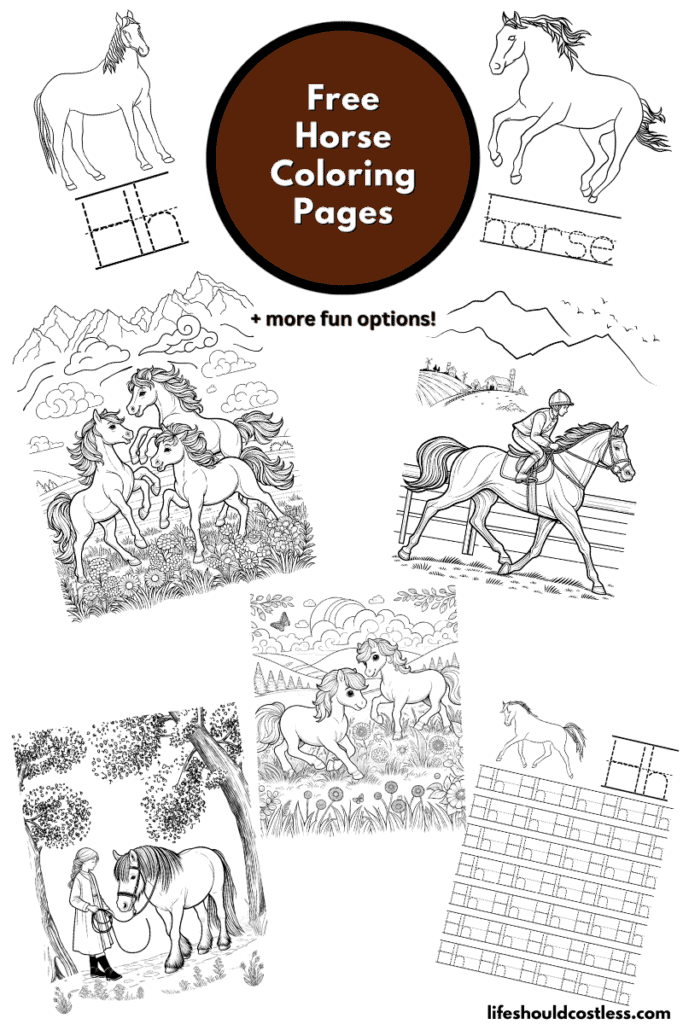
Explore and pick any design that inspires you.
Just select the design you like, download the free PDF, print it out, and dive into a world of limitless coloring creativity.
Additionally, these designs can double as embroidery patterns or spark ideas for detailed fine line tattoos.
Your imagination sets the boundaries for what’s possible.
Horse facts
If you’re just discovering my coloring pages, I want to highlight that I take pleasure in offering you a chance to immerse yourself in the topic.
This approach allows you to turn your coloring activity into a learning adventure.
So, without further ado, let’s get started!
Below, you’ll find a collection of fun, engaging, and simplified facts about horses:
- Domestication History: Horses have been domesticated for over 5,000 years, originally in the steppes of Central Asia.
- Brain Size: An adult horse’s brain weighs about 22 ounces (624 grams).
- Teeth vs. Brain: Horse’s teeth occupy more space in their head than their brain due to their long teeth that grow throughout most of their life.
- Lifespan: The average lifespan of a horse is between 25 to 30 years, with the oldest recorded horse, “Old Billy,” living to 62 years.
- Sleeping Habits: Horses can sleep both lying down and standing up thanks to a special locking mechanism in their legs.
- Measurement in Hands: The height of a horse is measured in hands, where one hand equals 4 inches (10.16 cm). The tallest horse, Big Jake, stood at 20 hands 2.75 inches (82.75 inches or 210.19 cm).
- Mobility after Birth: Horses can run shortly after birth, with foals standing and running within a few hours.
- Gallop Speed: The average gallop of a horse is around 27 mph (43.5 km/h), with the fastest recorded sprinting speed at 55 mph (88.5 km/h) by a Quarter Horse.
- Field of Vision: Horses have nearly a 360-degree field of vision, with small blind spots directly in front and behind them.
- Breed Diversity: There are over 300 breeds of horses, from the small Shetland pony to the massive Belgian draft horse.
- Hoof Composition: A horse’s hoof is made of keratin, the same protein in human hair and fingernails.
- Truly Wild Horse: The Przewalski’s horse is the only truly wild horse species still existing today.
- Sense of Balance: Horses have an excellent sense of balance and a highly developed sense of proprioception.
- Record Race Time: The fastest time for a 2-mile race is 3 minutes and 21.40 seconds by Secretariat in 1973 at the Belmont Stakes.
- Saliva Production: Horses produce approximately 10 gallons (about 37.85 liters) of saliva a day for food digestion.
- Group Terminology: A group of horses is usually called a herd, but can also be referred to as a team or a band.
- Facial Expressions: Horses communicate feelings through facial expressions, using ears, eyes, and nostrils.
These facts underscore the complexity, versatility, and beauty of horses, making them one of the most fascinating animals to learn about and observe.
We learned lots about horses, but there’s much know to know.
If you would like to read more about them, here are some other reputable resources to check out.:
- https://en.wikipedia.org/wiki/Horse
- https://kids.britannica.com/kids/article/horse/353265
- https://anequestrianlife.com/2023/03/how-to-get-started-with-horses/
- https://equinehelper.com/know-about-horses/
- https://www.amnh.org/explore/ology/zoology/all-about-horses
- To see all of my free printables, go here.
- If you would like to see an alphabetized index of free printable coloring pages, go here!
- All of my animals coloring pages are found here.
- Or, my other mammals coloring pages can be found here.
Tips for coloring
Coloring pictures of horses can be a delightful and rewarding activity, allowing you to bring these majestic creatures to life with your own creative touch.
Here are some of my best tips and tricks to enhance your coloring experience and achieve beautiful results when creating your horse-themed artwork:
- Study Real Horses: Before you start, look at pictures or observe real horses if possible. Pay attention to their natural colors, markings, and the way light plays on their coats and muscles.
- Choose the Right Materials: Use quality coloring pencils, markers, or watercolors, depending on your preference and the paper type. Soft pencils are great for blending, while markers can provide vibrant colors.
- Layer Your Colors: Start with light pressure and build up color gradually. Layering helps create depth and realism in your coloring. For instance, begin with a light tan base for a bay horse and add layers of brown or red to build up the color.
- Blend for Realism: Blending colors can mimic the smooth transitions seen in a horse’s coat. Use a blending pencil or a slightly damp brush (for watercolor pencils) to blend colors seamlessly.
- Use References for Accuracy: Keep a reference photo handy for accurate coloration and markings. Each horse breed has distinct features and colors, so a reference can guide your color choices and patterns.
- Add Highlights and Shadows: Identify the light source in your picture and add highlights to areas where light naturally hits and shadows where it doesn’t. This will give your horse a more three-dimensional appearance.
- Experiment with Textures: Horses have various textures, from the sleek coat to the rough mane and tail. Use different strokes to mimic these textures—short strokes for fur and longer, flowing lines for the mane and tail.
- Don’t Forget the Background: A thoughtfully colored background can make your horse stand out even more. Consider the horse’s natural habitat or where you imagine it could be, but keep the background colors softer to keep the focus on the horse.
- Practice Patience: Take your time with each section of the horse, especially with complex areas like the face and legs. Rushing can lead to mistakes or a less polished finish.
- Personalize with Creative Liberties: While realism is rewarding, don’t be afraid to use imaginative colors and patterns. Fantasy horses with unusual colors or whimsical elements can be just as beautiful and allow your creativity to shine.
- Highlight Musculature: Pay attention to the horse’s muscle lines and bone structure. Slightly darker shades along these lines can help define the horse’s physique and add realism.
- Use a Fine Tip for Details: For intricate areas like the eyes, hooves, and hair strands, use a fine-tipped pen or pencil. Details can significantly impact the overall look of your horse.
By incorporating these tips into your coloring process, you can create stunning and lifelike depictions of horses that capture their grace and power.
Whether you’re a beginner or an experienced colorist, there’s always room to experiment and improve your technique.
Options For Printing:
Letter H is for horse writing practice worksheets
*My letter H is for horse coloring sheet printables available here are uniquely crafted for classroom use and represent the sole printables on this page that can be utilized in a public setting without requiring written consent.
Nevertheless, should anyone inquire about their origin, kindly direct them to this post by sharing the link.
Thank you!
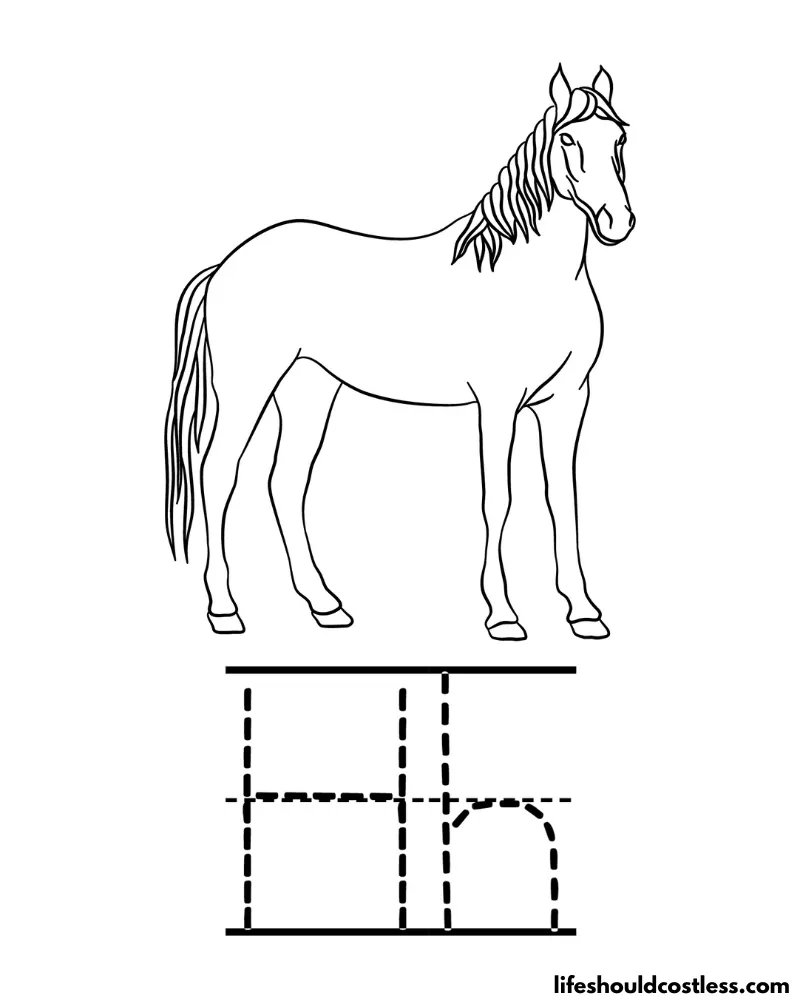
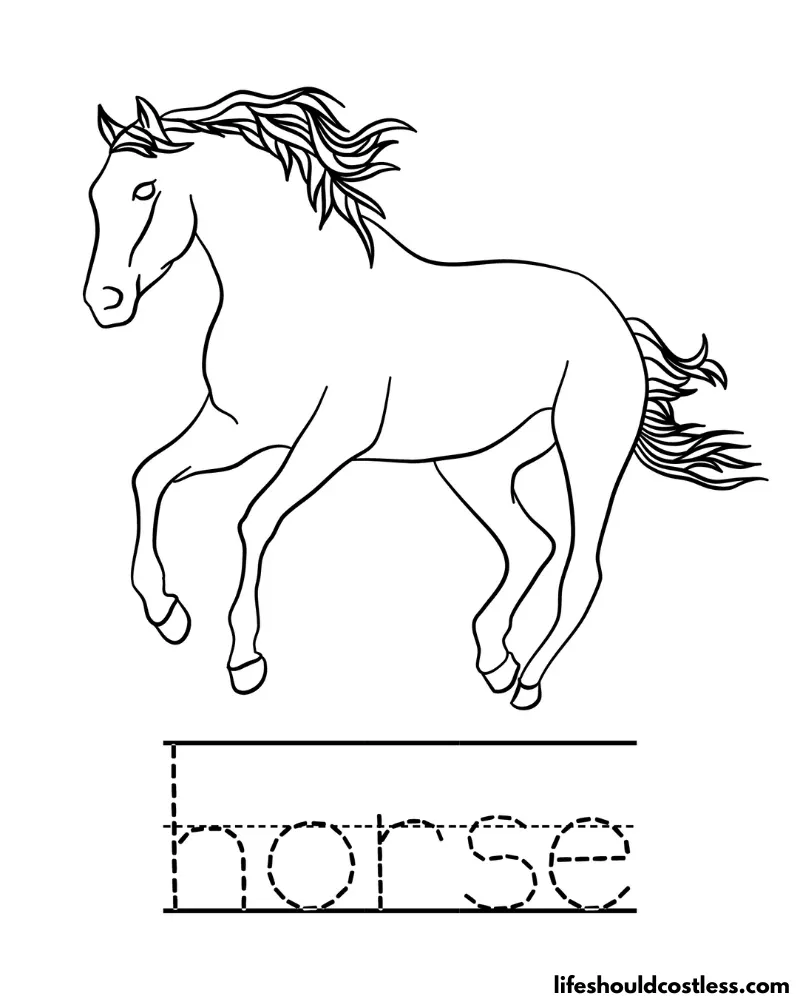
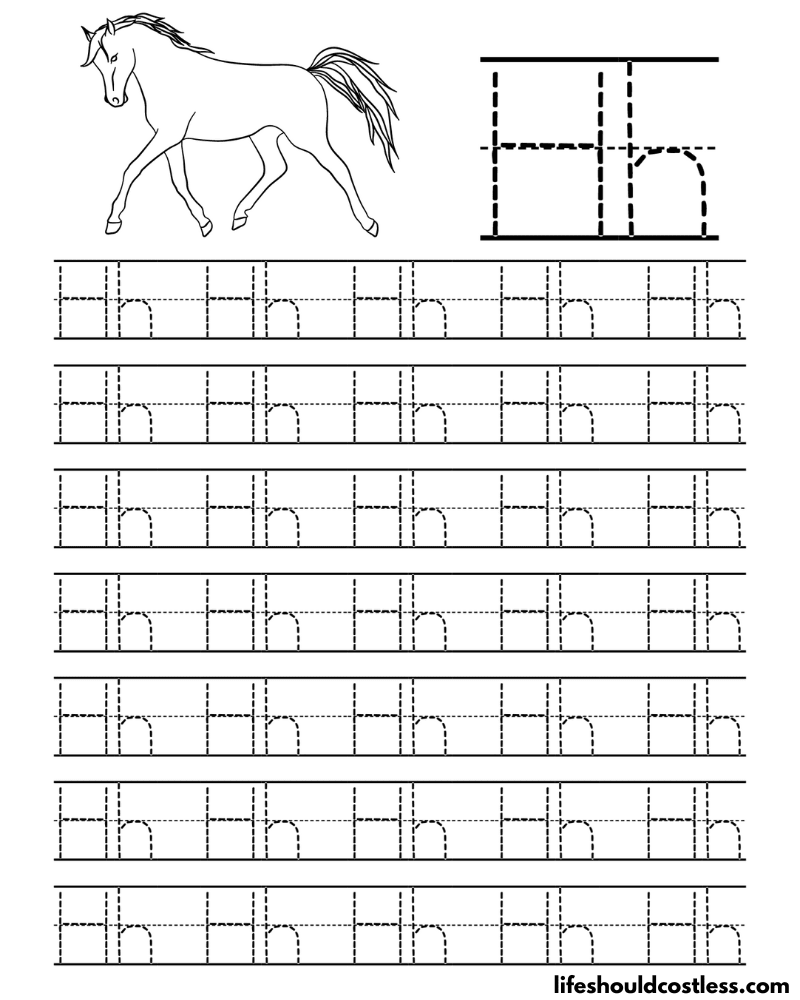
Various horse designs
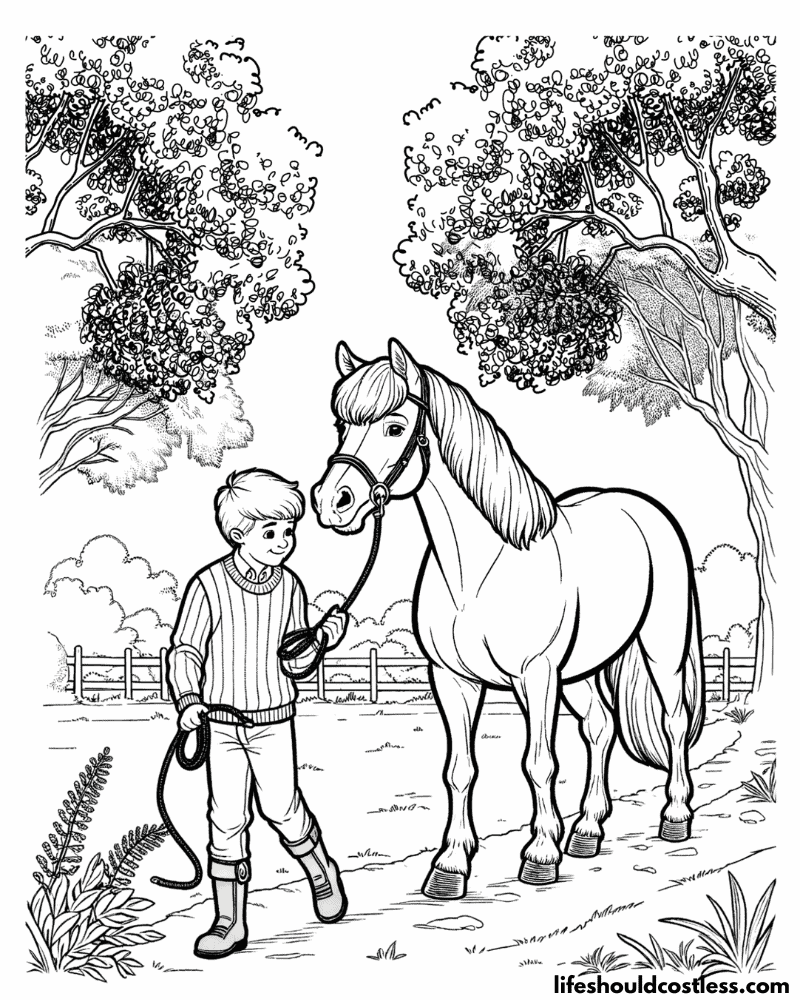
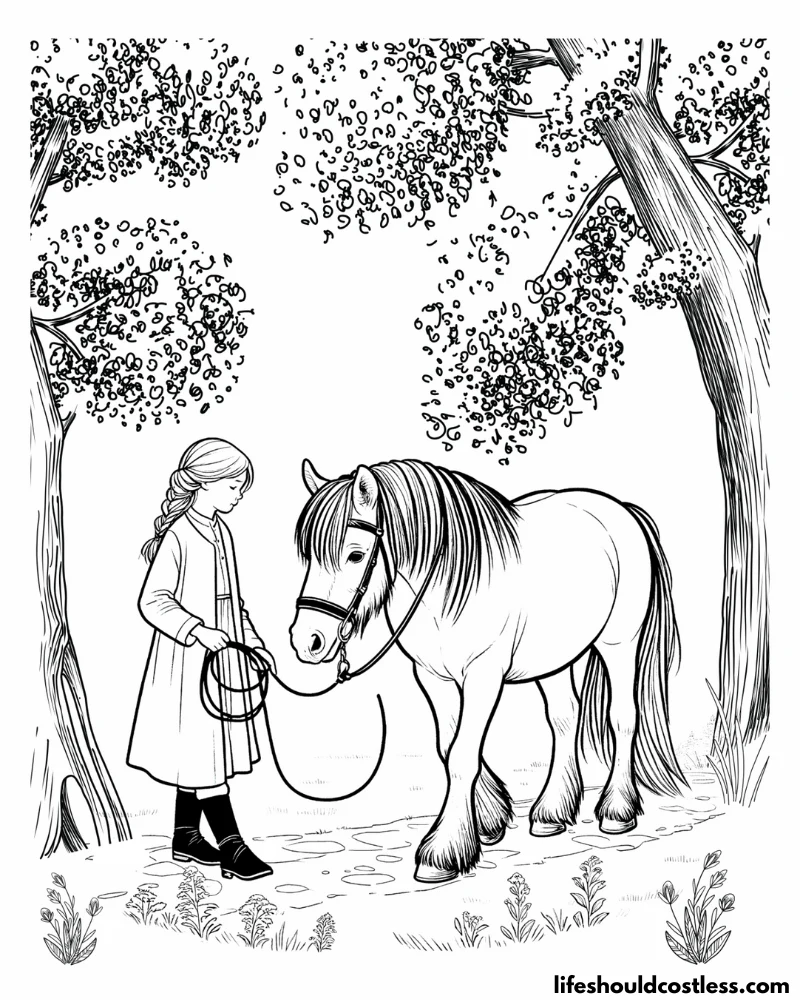
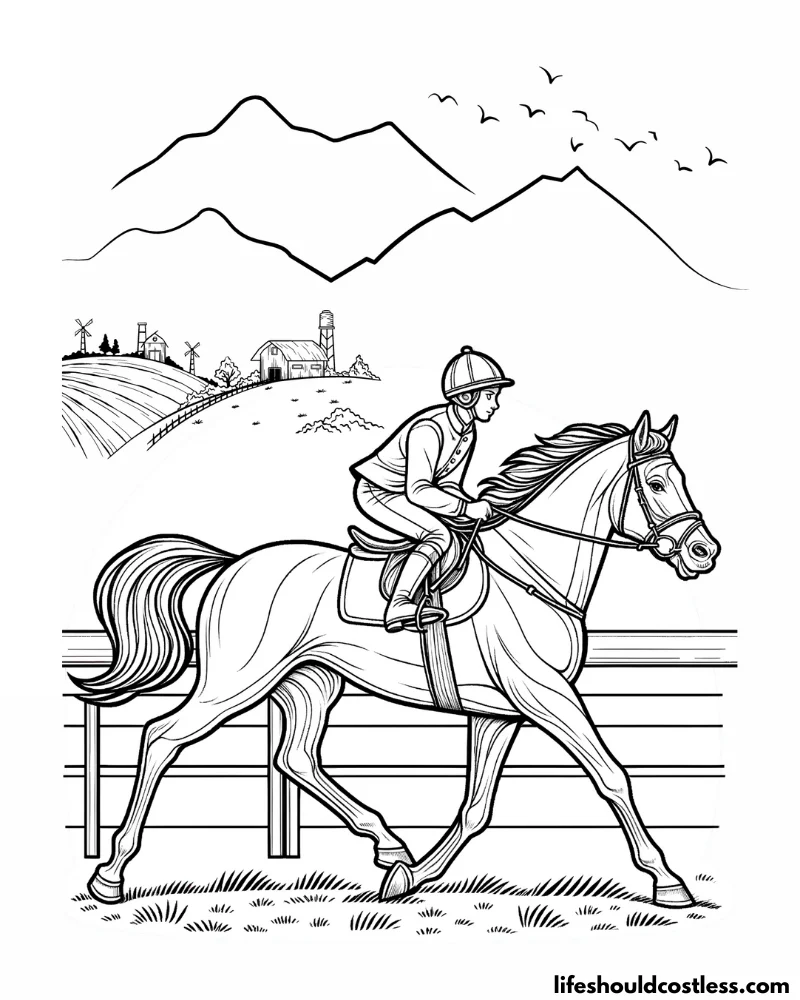
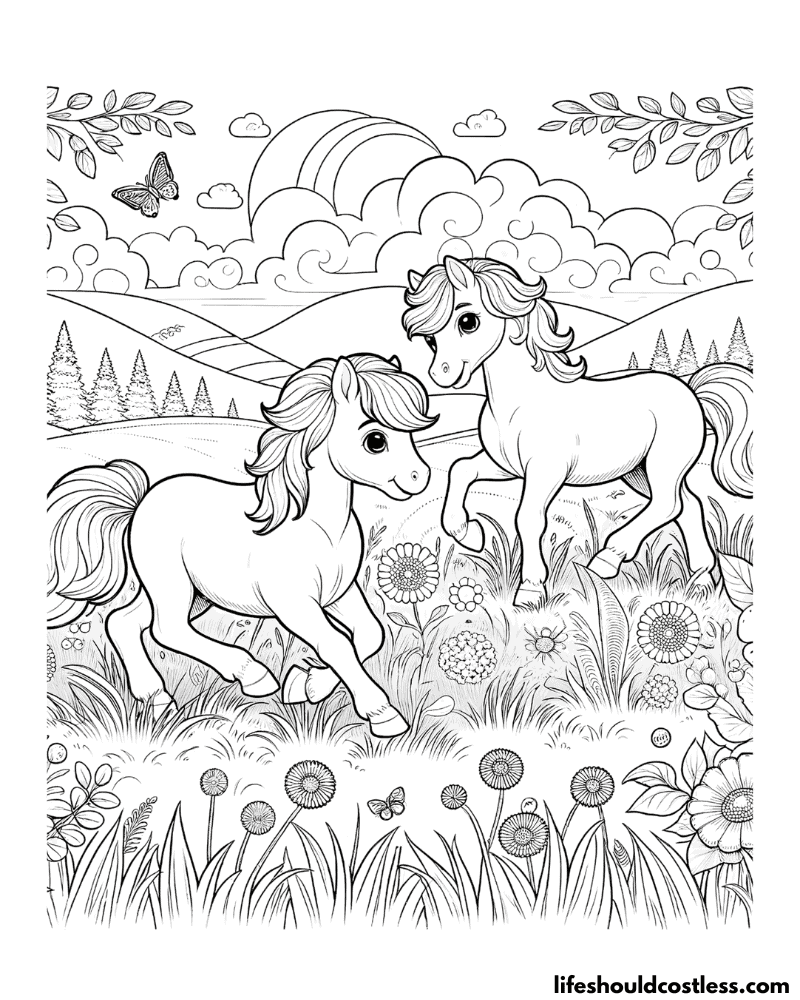

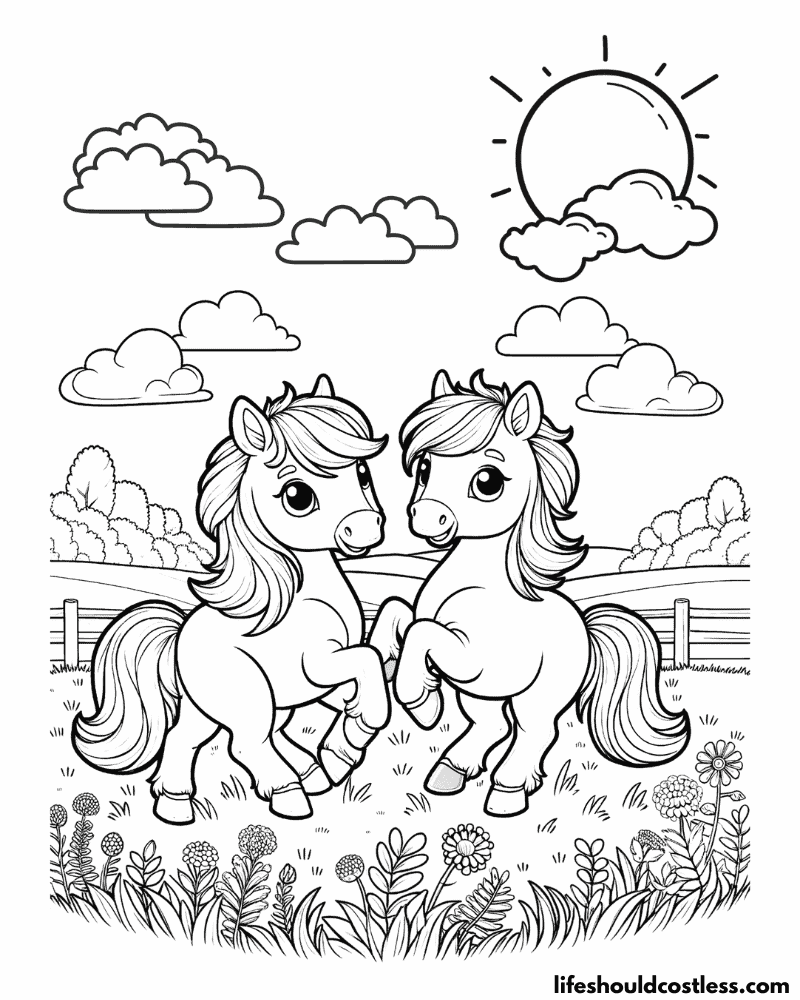
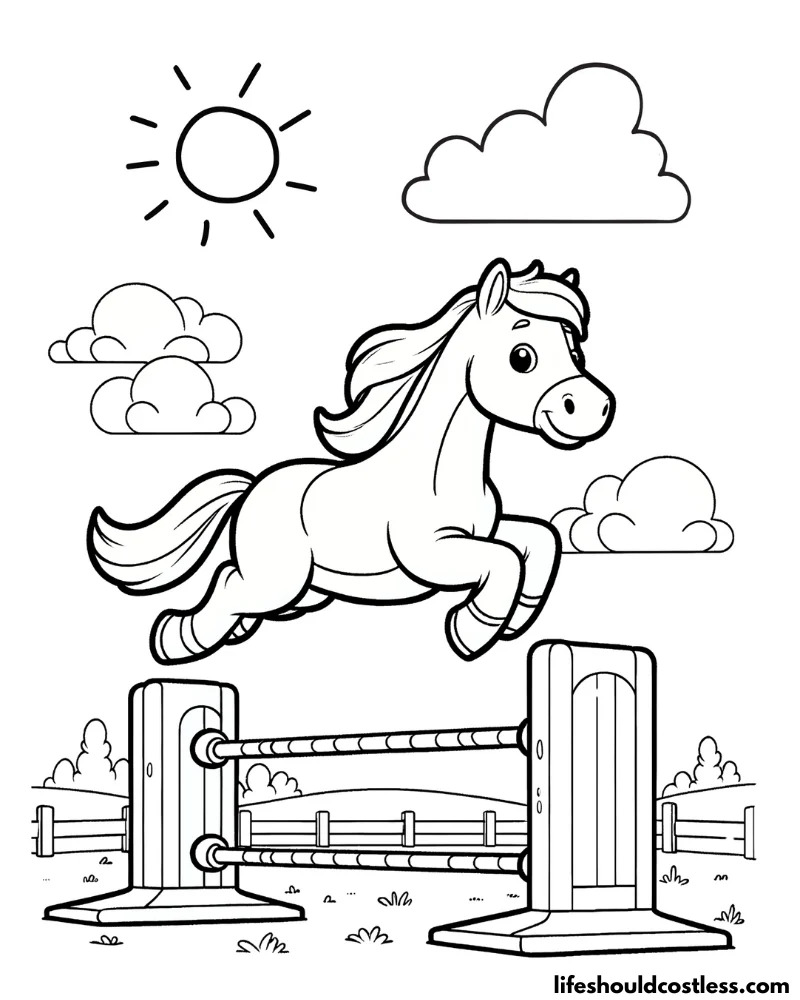
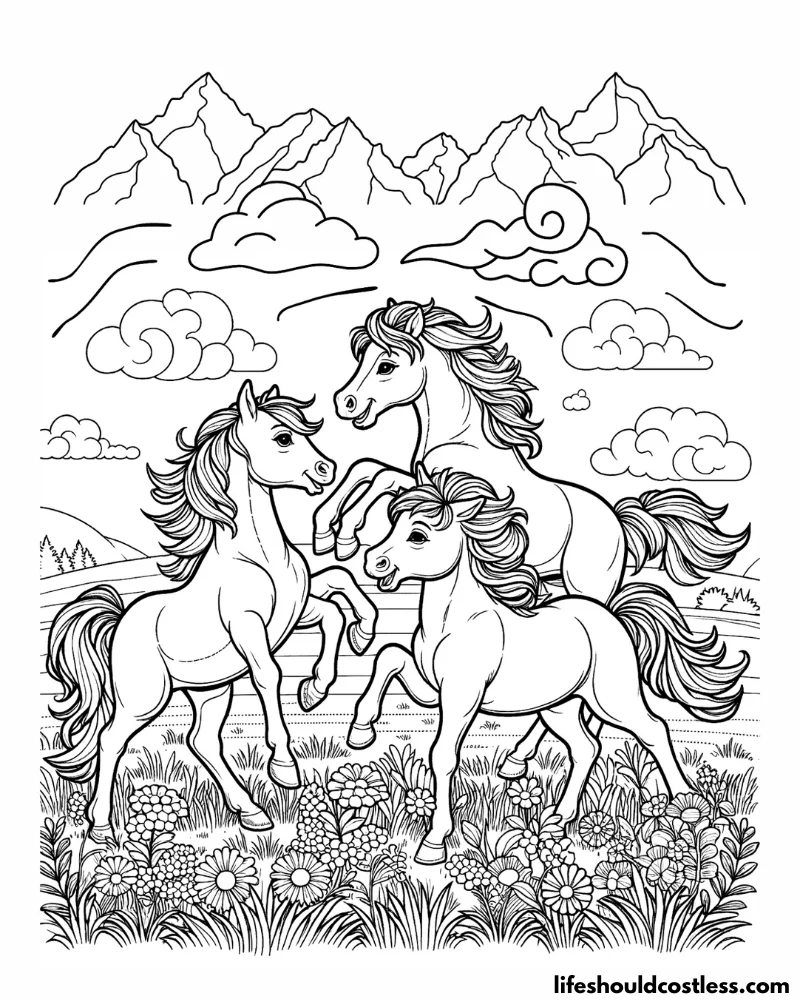
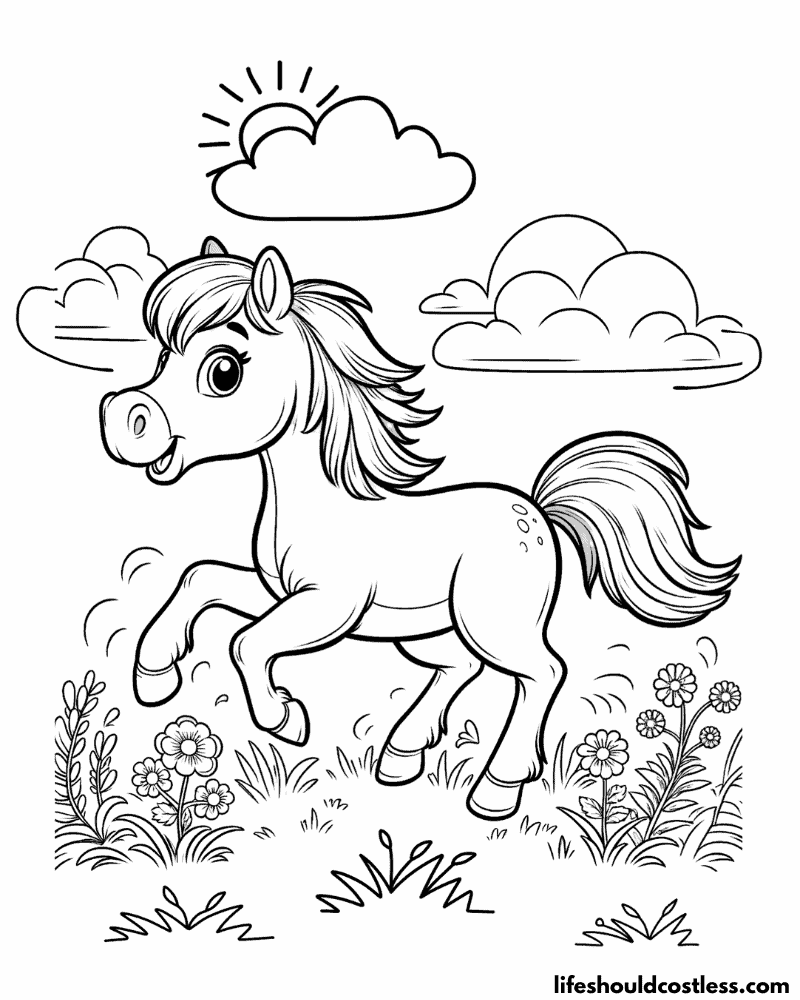
FAQ’s
Horses come in a wide variety of colors, and their coats are often one of their most distinctive features.
The most common horse colors include:
Bay: A reddish-brown coat with a black mane, tail, and lower legs. Bay is one of the most common horse colors and can range from a light copper red to a rich, almost chocolate brown.
Chestnut (Sorrel): This color ranges from a light, golden-red to a deep, reddish-brown. Chestnuts have the same color or lighter manes and tails, and the term “sorrel” is often used interchangeably in some regions, though it typically refers to the lighter, more reddish-orange shades.
Black: True black horses have a solid black coat, mane, and tail without any light or brown areas. Black horses can fade to a rusty black if exposed to sunlight but are still considered black.
Grey: Grey horses start with a darker coat at birth and progressively lighten as they age, eventually becoming almost white. Their skin remains black, distinguishing them from true white horses. Grey horses can show a mixture of black and white hairs or develop a pattern of white hair over their body.
White: True white horses are rare and have a pure white coat from birth with pink skin and often blue or dark eyes. This is different from grey horses, which may become white with age but have dark skin.
Palomino: Palominos have a golden-yellow coat with a white or light cream mane and tail. The shades of gold can vary significantly from light to dark.
Buckskin: Buckskins have a tan or gold-colored coat with a black mane, tail, and lower legs, similar to bays but with a lighter, yellowish or golden coat.
Dun: Duns are characterized by a golden, grey, or reddish coat with “primitive” markings such as a darker dorsal stripe, shoulder stripes, and leg barring. Their mane and tail are usually darker than their body.
Pinto: Pinto horses have large patches of white and another color, which can be black, brown, or any other color. The pattern variations include overo (white does not cross the back), tobiano (white crosses the back), and tovero (a mix of tobiano and overo patterns).
Appaloosa: Known for their spotted coat patterns, Appaloosas can have a base coat of any color with various spotting patterns overlaying it, including leopard (spotted all over), blanket (white over the hip with spots), and few spot (almost entirely white).
These colors, along with their various shades and patterns, contribute to the beautiful diversity found in horses around the world.
*I will add more horse colour / color questions and answers as the questions get sent to me.
Conclusion
In conclusion, our horse coloring pages offer a splendid avenue for individuals of all ages to connect with the grace and spirit of these noble animals through the medium of art.
They serve not only as a source of enjoyment and relaxation but also as educational tools that provide insights into the diverse world of horses, their colors, breeds, and habitats.
Whether used in a classroom to enhance learning or at home for a peaceful creative escape, these coloring pages can spark curiosity and foster a deeper appreciation for horses.
By exploring various designs, from realistic portrayals to fantastical interpretations, colorists can unleash their creativity, experiment with colors and textures, and develop their artistic skills.
So, the next time you pick up a coloring page featuring a majestic steed, remember that you’re not just filling in spaces with color; you’re beginning on a journey that celebrates the beauty and mystery of horses, enriching your understanding and connection with these magnificent creatures.
Thanks so much for stopping by my blog and supporting my endeavors to make people’s lives a little easier/better/more affordable.
If you liked this post, or found it helpful in any way, please make sure to share it with your family, friends, and co-workers via social media.
Or you could even send them the direct link via email. Whichever way you choose to spread the love, I super appreciate it! ~Sarah
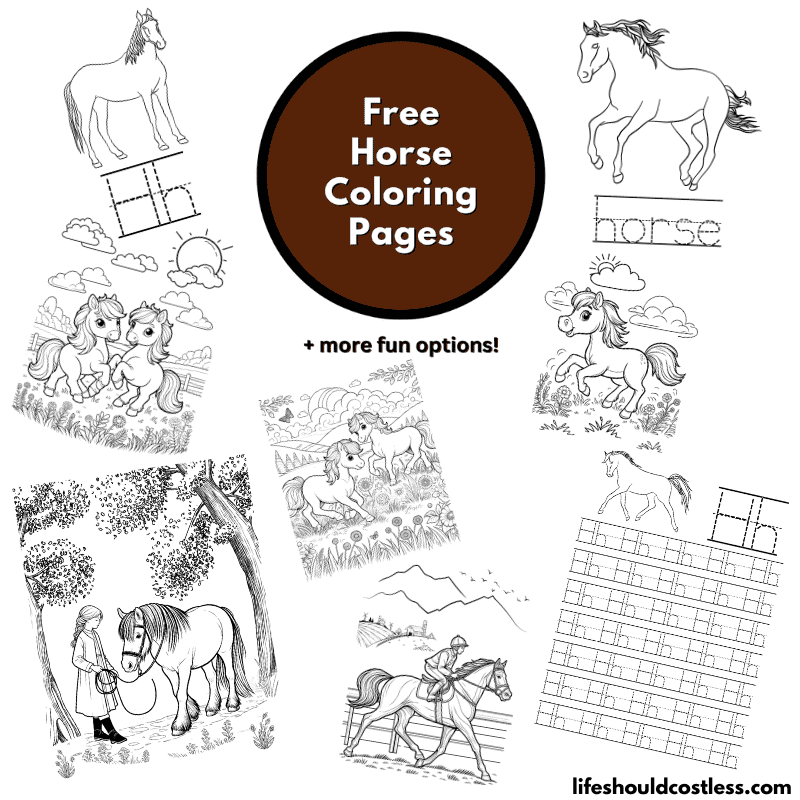
How To Follow & Support This Site
- If you would like to subscribe to my email list, go here.
- Make sure to follow along via social media, by going here.
- If you would like to learn how to really show your support to this site (at no cost to you), go here.
- If you would like to make a direct donation to the site, go here.
Check out my other free printables
- To see all of my free printables, go here.
- If you would like to see an alphabetized index of free printable coloring pages, go here!
- All of my animals coloring pages are found here.
- Or, my other mammals coloring pages can be found here.
Otherwise, here are direct links to several of my other related posts that you’re also going to love:
Animals / Mammals
Animals / Birds
Animals / Insects
Other good resources for a printable horse
- https://www.breyerhorses.com/blogs/coloring-pages/tagged/coloring
- https://www.bestcoloringpagesforkids.com/horse-coloring-pages-for-adults.html
- https://www.coloring-page.net/horse.html
*This post was originally shared to this blog on 02/06/2024, and has since been updated to improve user experience, possibly add video instruction, as well as to make it as shareable as possible across the social medias.
**Please note that I do try my hardest to provide factual, but easy to understand, information about each topic. If you notice a discrepancy in my coloring pages, facts, or see something that you deem “misinformation/incorrect” please make sure to notify me about it. I would prefer that you send me an email with a link to a more reputable resource on that subject, so that I can correct it as soon as possible. Thanks so much for helping this site become the best that it can be!
***Resources from djinkers were used in the production of this article.
